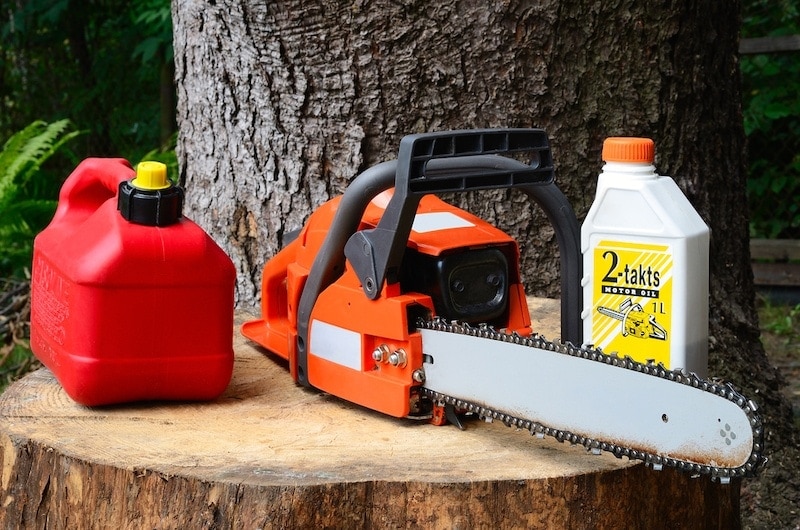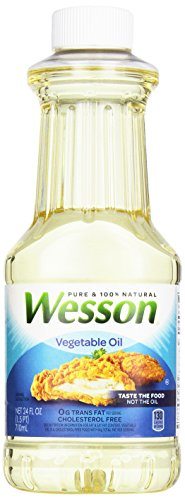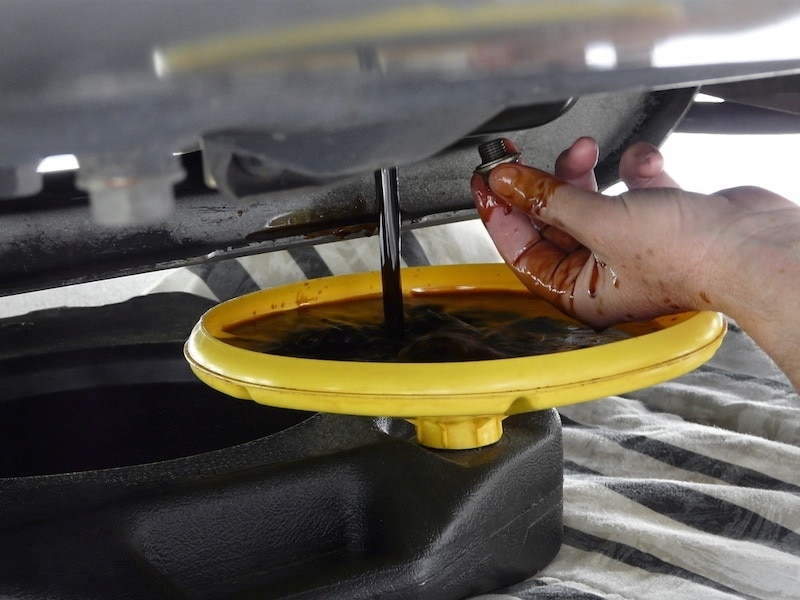6 Chainsaw Bar & Chain Oil Alternatives That May Save You Money
-
- Last updated:


Anyone who has ever used a chainsaw knows how crucial it is to keep the chain and bar well oiled. Proper lubrication keeps blades running smoothly and prevents friction which can cause damage to your tool and dangerous heat build-up.
Your chainsaw’s manufacturer likely has recommendations for what bar and chain oil works best for your tool. But the recommended lubricants can be costly, and sometimes the best choice simply is not available when you need it.
Lucky for you, we have compiled four commonly found alternatives to expensive chainsaw bar and chain oil—plus two last-ditch variations to be used only in the most desperate of times. Hopefully, this list can save you time and money if you find yourself in a pinch!

The 6 Best Chainsaw Bar & Chain Oil Alternatives
1. Vegetable Oil

Vegetable oil is one of the safest alternatives available to oil your chainsaw. It is completely non-toxic and biodegradable, and can even be used to trim live trees without danger of hurting you or the plants! And boy is it cheap—you may even have it in your kitchen right now.
The viscosity of vegetable oil also means that you can use it without dilution if necessary. But the tradeoff is that this oil is prone to clumping and becoming unusable in cold weather.
- Safe, non-toxic, biodegradable
- Sticky, fairly viscous
- Inexpensive
- High flash point
- Clumps at lower temperatures
2. Canola Oil

Similar to vegetable oil, canola oil is another super-safe alternative. Canola is made solely from rapeseed oil and is significantly less sticky than vegetable oil. Canola clings to the chain much better when used in low temperature conditions.
The viscosity does not make canola oil a good permanent solution, but it can be incredibly useful for diluting other oils or on snowy days!
- Safe, non-toxic, biodegradable
- Little to no fumes
- Performs well in low temperatures
- High flash point
- Not very sticky, better as additive
3. Motor Oil

Motor oil can make a decent, last-resort oil for your chainsaw. You can find it sitting around in most people’s garages, and it has excellent viscosity and a high flash point.
However, motor oil should not be used to replace the chain and bar oil recommended by your chainsaw’s manufacturer. When using a chainsaw, the spinning blades fling droplets of oil everywhere—into the air, the surrounding environment, and onto the person using it.
It is toxic to plants, so do not use it in your garden or on living trees. And what’s more, do you really want to be possibly breathing in motor oil on a regular basis? Yeah, we didn’t think so. Better to use it sparingly as an occasional dilution of safe oil.
- Incredibly viscous, stays on chain
- High flash point
- Easily found in most garages
- Contains cleaners, not just oil
- May be harmful to inhale
- Cannot be used on living plants
4. Hydraulic Fluid (Diluted)

Hydraulic fluid is similar to motor oil in that it also has a high flash point and superior lubrication abilities. Commonly used in automotive brake systems, you may already have some hydraulic fluid in your garage.
Hydraulic fluid is significantly less viscous and does not stick to the chain well. But if you are dangerously low on your regular oil, it can be added to what you’ve got left to extend your usage period.
Never use hydraulic fluid without proper safety gear. It can be extremely dangerous at high pressures, and you should avoid any contact with skin or inhalation. Hydraulic fluid should be a backup, never your go-to alternative.
- High flash point
- Inhibits rust and corrosion
- Good for extremely low temperature use
- Should never allow contact with skin, or inhale it
- Mineral oil based, not sticky
- Harmful to living plants
The Last-Resort Options
As mentioned above, motor oil and hydraulic fluid can be mixed with the existing chainsaw bar and chain oil to extend its lifespan. If you need a quick-fix to finish the last 15 minutes of a job, these two options can keep you cutting. However, by no means, are these permanent solutions. Furthermore, you should be experienced in handling dangerous materials before attempting to use hydraulic fluid with your chainsaw.
5. Drained Motor Oil (Diluted)

As a backup, used motor oil is a super cheap, effective way to add volume to your last bit of chainsaw oil. If you have a car, you definitely have some used motor oil!
Filter it first to prevent clogs and nasty buildup. After all, used motor oil has already been through an engine and will likely be full of contaminants. Used oils often have water and air, and some will have additives and abrasive particles like metal that could damage your chainsaw over time.
It certainly isn’t the safest option for you or any plants nearby your sawing work, and we don’t recommend using motor oil on a regular basis anyway, never mind drained motor oil. Be advised that filtering used motor oil is messy, time-consuming, and not as easy as it sounds.
- High flash point
- Thrifty use of a waste product
- Very sticky, viscous
- Contains cleaners, not just oil
- May be harmful to inhale
- Cannot be used around living plants
- Used, may affect long term performance
- Filtering may not remove all contaminants
6. Drained Hydraulic Fluids (Diluted)

Hydraulic fluid that has been drained from other machinery can be a great way to lubricate your chainsaw in a pinch, or even stretch out your usual chainsaw bar and chain oil.
One of the main things to keep in mind, however, is that hydraulic fluid can potentially cause serious injury. It is inadvisable to allow any to come into contact with your skin, and when highly pressurized it is extremely dangerous.
Also, used hydraulic fluid is full of contaminants from its use and is likely somewhat degraded. Contaminants include water, air, or even abrasive substances that have leaked into the fluid. Filtering is advised, but long-term use of used hydraulic fluid may affect the lifespan of your chainsaw.
- High flash point
- Thrifty use of a waste or by-product
- Good for extremely low temperature use
- Should never allow contact with skin, or inhale it
- Cannot use around living trees
- Mineral oil based, less sticky
- Used, may affect long-term performance
- Filtering may not remove all contaminants
How to Filter Used Motor Oil and Hydraulic Fluid
Again, we’d like to remind you that filtered used motor oil is not a good long-term solution for chainsaw bar and chain oil. Filtered used oil is not the same as reclaimed (aka recycled) oil, which is free of contaminants, impurities, and debris. With filtered oil, you’re simply removing the larger debris like tiny shards of metal. Filtering does not remove the impurities caused by combustion.
Filtering Used Motor Oil
Because you won’t be needing a large amount of motor oil or hydraulic fluid, you could – if you were so inclined – filter the used oil or fluid in several ways.

The Quick & Easy Way: The first and most obvious is to use a large, empty plastic bottle, a funnel, and some cheesecloth or other clean, semi-porous fabric. Stretch the fabric across the funnel and pour the oil gently through the fabric.
The Long & Time-Consuming Way: Save your used motor oil in a 55-gallon steel drum. Cover and let sit for 1-2 months. The debris and loose materials will settle to the bottom. When you see a clear separation between viscous fluids – the bottom will be darker – skim the oil from the top, being careful not to disturb the surface tension too much.
The Professional Way: Watch this video to see how a super-smart guy filters his used motor oil:
Filtering Hydraulic Fluid
You could filter your used hydraulic fluid The Quick & Easy Way mentioned for motor oil, but to be blunt, you’d be getting into pennywise and pound foolish territory. Anybody who’s familiar with hydraulic fluid would be using a special filtration cart.

Key Considerations of Chainsaw Bar & Chain Oil
- Because chainsaws splatter the bar and chain oil you choose all over the place, it is highly advisable to use non-toxic oil whenever possible.
- For some projects non-toxic oil is a necessity: when pruning a living tree, sawing in your garden, or working near a river or pond.
Viscosity
- Chainsaw lubricant needs to be especially viscous and tacky to stick to the rapidly spinning chain. If an oil is too thin it won’t coat the chain at all!
Flash point
- The “flash point” of any given substance is the lowest temperature at which the vapors can ignite. The higher the flash point, the hotter the substance needs to be before there is any danger of combustion.
- Choosing a bar and chain oil with a high flash point is incredibly important due to the extreme speeds that chainsaws can reach, which in turn create extreme heat. To avoid fires and harmful fumes, stick to high flash point lubricants when deviating from the manufacturer’s recommended bar and chain oil.

Chainsaw Maintenance: What to Avoid
FrictionIf your chainsaw suddenly starts using more fuel than usual, it is likely because there is increased friction between the bar and the chain. It could be that the oil you started using just isn’t cutting it, or maybe it is running low.
Pro tip: top off your fuel and oil together, so that you never inadvertently run out of oil and cause damage to your chainsaw.
Toxic substances
As your chainsaw’s blades rotate, they also fling the oil you are using to lubricate it off into the air. And that means that you and any nearby plants will get that lubricant – and whatever is in it – all over.
For safety, your regular bar and chain oil should be non-toxic. Cover any exposed skin before starting, and only use chainsaws in areas with proper ventilation.

Conclusion
Perhaps you’re running low on your favorite chainsaw oil, and only halfway through a time-sensitive project. Or maybe you want to try a totally non-toxic alternative so that you can saw some limbs off a living tree in your yard.
Sometimes it’s just not possible to stick to the chain lubricant recommended by your chainsaw’s manufacturer. But we hope that this list of 6 alternative chain and bar oils will help you get the most out of every bottle of chainsaw oil, and save you some time and money in the process!
Featured and header image credit: AS-kom, Shutterstock
Contents

